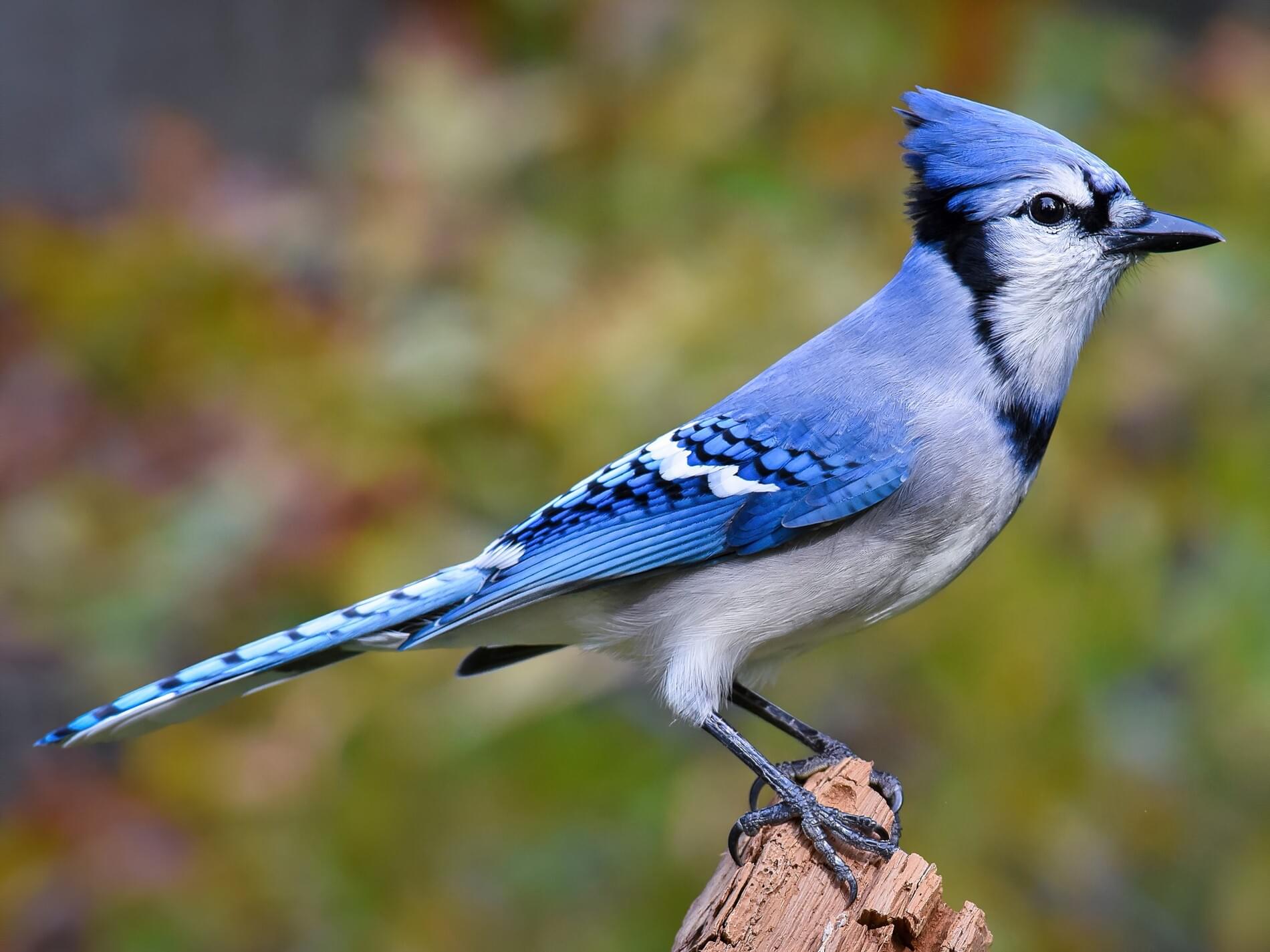Blue Jays


The Blue Jay (Cyanocitta cristata) is a vibrant and intelligent bird common throughout North America. Known for its striking plumage and loud calls, the Blue Jay is a fascinating species that plays a significant role in its ecosystem.
Physical Characteristics
Blue Jays are medium-sized birds, measuring approximately 10-12 inches in length with a wingspan of 15-18 inches. They are easily recognizable by their distinctive bright blue plumage, with black and white markings on their wings, tail, and head. The Blue Jay’s most notable feature is its crest, a prominent tuft of feathers that can be raised or lowered depending on its mood. They also have a black “mask” that extends from their bill to their eyes.
Habitat Preferences
Blue Jays are adaptable birds that thrive in a variety of habitats, including woodlands, forests, parks, and even suburban areas. They prefer mature deciduous forests with a mix of oak, hickory, and maple trees, as these provide ample food sources and nesting sites. Blue Jays are found throughout eastern and central North America, from southern Canada to the Gulf of Mexico. They are particularly common in the eastern United States and southeastern Canada.
Diet
Blue Jays are omnivorous birds with a varied diet that includes a wide range of food sources. They are primarily insectivores, feeding on insects such as caterpillars, beetles, and grasshoppers. However, they also consume nuts, seeds, fruits, berries, and even small vertebrates like frogs and lizards. Blue Jays are opportunistic feeders and will readily scavenge for food, often visiting bird feeders and garbage dumps. They have a strong beak that allows them to crack open nuts and seeds, and their sharp claws help them to grasp and manipulate food items.
Vocalizations
Blue Jays are known for their loud and varied vocalizations, which they use for a variety of purposes, including communication, territorial defense, and attracting mates. Their calls are often described as raucous, harsh, and penetrating. They have a wide range of calls, including a distinctive “jay” call, a sharp “kweek” call, and a high-pitched “whee” call. Blue Jays also sing a simple, repetitive song that is often heard during the breeding season.
Role in the Ecosystem
Blue Jays play an important role in their ecosystem, particularly in seed dispersal. They cache seeds in various locations, often burying them in the ground or storing them in tree cavities. This behavior helps to regenerate forests and create new plant communities. Blue Jays are also known to prey on insects, helping to control populations of pest insects. However, they can also be considered a nuisance by some people, as they can be aggressive towards other birds and sometimes raid bird feeders.
Blue Jays: Behavior and Social Interactions

Blue jays, with their vibrant plumage and bold personalities, are fascinating creatures that exhibit a complex social structure and a wide range of behaviors. They are highly intelligent birds that engage in intricate communication, exhibit territoriality, and demonstrate remarkable problem-solving skills.
Social Structure and Flocking Behavior
Blue jays are known for their gregarious nature and often gather in flocks, especially during the non-breeding season. These flocks can vary in size, ranging from a few individuals to hundreds of birds. Flocking behavior provides several advantages, including increased vigilance against predators, improved foraging efficiency, and enhanced social learning opportunities.
Territoriality and Interactions with Other Birds
Blue jays are highly territorial, particularly during the breeding season. They defend their territories fiercely, often engaging in aggressive displays and vocalizations to deter rivals. These displays include wing-fluttering, crest-raising, and loud calls. While they are known to be aggressive towards other blue jays, they also engage in interactions with other bird species, sometimes forming mixed flocks with species like chickadees and nuthatches.
Mating Rituals, Blue jays
Blue jay mating rituals involve a series of elaborate courtship displays. Males often perform a “bowing” display, where they bend their heads and necks, while fanning their tail feathers and making soft, cooing sounds. They may also offer food to potential mates, a gesture of courtship and parental care.
Nest Building and Parental Care
Once a pair has bonded, they will build a nest together. Blue jays typically build their nests in trees, often high up in the canopy. The nests are constructed from twigs, leaves, and other natural materials. Both parents participate in incubating the eggs and caring for the young. They bring food to the nestlings and defend them from predators.
Communication Methods
Blue jays communicate through a variety of vocalizations, including calls, songs, and alarm calls. They have a repertoire of distinct calls, each with a specific meaning. For instance, they use a “j-j-j-j-j-j” call to alert others to danger, and a “whee-whee-whee” call to communicate with their mates.
Intelligence and Problem-Solving Abilities
Blue jays are renowned for their intelligence and problem-solving abilities. They are known to cache food, storing it in hidden locations for later retrieval. They have excellent spatial memory and can remember the locations of their caches over long periods. They can also recognize individual humans and other birds, and they are adept at adapting to changing environments.
Comparison with Other Corvid Species
Blue jays share many behavioral similarities with other corvid species, such as crows, ravens, and magpies. They are all highly intelligent birds with complex social structures, strong territoriality, and sophisticated communication systems. However, there are also some notable differences. For instance, blue jays are generally more vocal and less shy than crows or ravens.
Blue Jays


The Blue Jay, with its striking plumage and boisterous calls, is more than just a common sight in North American woodlands. This intelligent and adaptable bird has held a prominent place in human culture for centuries, weaving its way into folklore, mythology, and artistic expression.
Cultural Significance and Symbolism
The Blue Jay’s cultural significance is deeply rooted in Native American traditions, where it is often revered as a symbol of wisdom, communication, and spiritual guidance.
The Blue Jay’s role in Native American folklore and mythology is diverse and multifaceted. In many tribes, the Blue Jay is considered a trickster figure, known for its cleverness and mischievous nature. The Cherokee people, for example, believe the Blue Jay was responsible for bringing fire to humans, but also for spreading gossip and causing trouble. Among the Ojibwe, the Blue Jay is associated with the spirit world and is believed to be able to communicate with the dead. Its vibrant blue plumage is often seen as a symbol of spiritual power and connection to the heavens.
Beyond Native American cultures, the Blue Jay’s symbolism extends to other parts of the world. In some European traditions, the Blue Jay is associated with good luck and fortune, while in others, it is seen as a harbinger of change or a symbol of adaptability.
The Blue Jay’s association with intelligence, adaptability, and communication is evident in its behavior. Its ability to mimic other birds and even human voices is a testament to its remarkable cognitive skills. This ability to learn and adapt has led to the Blue Jay being seen as a symbol of wisdom and knowledge in various cultures.
| Culture | Symbolism | Folklore | Art and Literature |
|---|---|---|---|
| Native American (Cherokee) | Trickster, fire-bringer, messenger | Stories of the Blue Jay’s mischievous nature and role in bringing fire to humans. | Paintings, carvings, and storytelling traditions featuring the Blue Jay as a central figure. |
| Native American (Ojibwe) | Spirit guide, communicator with the dead | Beliefs about the Blue Jay’s ability to travel between the spirit world and the physical world. | Stories, songs, and dances honoring the Blue Jay’s connection to the spirit world. |
| European | Good luck, fortune, change, adaptability | Folk tales and legends associating the Blue Jay with positive omens and transformative events. | Paintings, sculptures, and literary works depicting the Blue Jay as a symbol of prosperity and change. |
The Blue Jay has also found its way into various works of art, literature, and music. Here are some notable examples:
- “The Blue Jay” by John James Audubon: This iconic painting depicts a Blue Jay perched on a branch, showcasing the bird’s vibrant plumage and striking features. Audubon’s work is known for its detailed and realistic portrayal of birds, and “The Blue Jay” is a testament to his mastery of avian art. The painting captures the bird’s striking beauty and emphasizes its importance as a symbol of the natural world.
- “The Raven and the Blue Jay” by Native American storyteller, Joe Medicine Crow: This story tells of a raven and a Blue Jay who compete for the favor of a beautiful maiden. The story highlights the Blue Jay’s cleverness and mischievous nature, while also emphasizing the importance of humility and respect. The story is a testament to the Blue Jay’s enduring presence in Native American storytelling traditions, showcasing its symbolic importance as a trickster figure and a symbol of wit and cunning.
- “The Blue Jay” by John Updike: This short story explores the themes of nature, memory, and the passage of time through the lens of a Blue Jay’s presence in a man’s life. The story captures the Blue Jay’s unique personality and its ability to evoke both joy and nostalgia. Updike’s work highlights the Blue Jay’s ability to connect with humans on an emotional level, showcasing its importance as a symbol of the natural world’s enduring power.
These examples illustrate the diverse ways in which the Blue Jay has been incorporated into human culture. From its role in Native American mythology to its appearances in art and literature, the Blue Jay continues to fascinate and inspire people around the world.
Blue jays, with their striking blue plumage and raucous calls, are a common sight in North American forests. Their bold personalities and territorial nature often remind us of the fierce spirit of a baseball team, like the New York Yankees , who have dominated the game for over a century.
Just as blue jays fiercely protect their nests, the Yankees have fiercely defended their home turf, Yankee Stadium, earning the nickname “The Bronx Bombers.”
Blue jays, with their striking blue plumage and bold personalities, are a common sight in many North American forests. Their calls, often described as a raucous “jay, jay,” echo through the trees, adding to the vibrant soundscape of nature. For a fascinating look at another kind of journey, check out the story of Gavin Sheets , a baseball player who has carved his own path in the sport.
Like the blue jay, Sheets demonstrates resilience and determination, making him a captivating figure to watch on the field.
